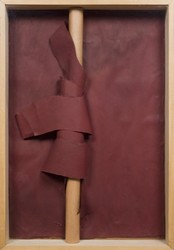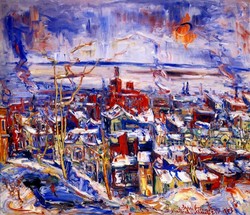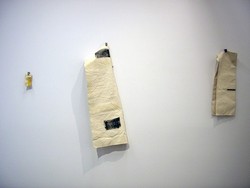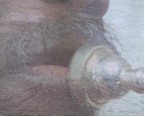Ensemble, An Exhibition of Art and Jazz
Jazz music provides an analogy for explaining modern and contemporary art, by using musical expressions such as distinctive tone colours, energizing and syncopated rhythms, pitch variations, pattern and improvisation. This exhibition features Canadian artists Sam Borenstein, Graham Coughtry, Jacques de Tonnancour, Yves Gaucher, Betty Goodwin, John Heward, Harold Klunder, Guido Molinari, Michael Snow, Sylvia Safdie and Joyce Wieland, whose works explicitly evoke associations with jazz. Whether it is through their experiences as jazz musicians, their love for music, or the jazz-like spontaneity communicated in their paintings, this art from the 1960s to the present day can be considered in musical terms.
The exhibition is an initiative of Concordia University's art history graduate students, working in partnership with the FOFA Gallery, the Gail and Stephen A. Jarislowsky Institute for Studies in Canadian Art, the Concordia University Archives and the Leonard and Bina Ellen Art Gallery. Most of the works for this exhibition were selected from the latter's collection. This exhibition was the result of a M.A. graduate seminar in Museum Practice taught by Loren Lerner in Fall 2007. The students defined the exhibition theme, selected the works, and handled different aspects of the exhibition, including: the design of the exhibition space; the preparation of the panel texts; the writing and presentation of the symposium papers; the development of the website; and the organization of an educational program to accompany the exhibition.
The organizers of the exhibition would like to encourage viewers to have a multi-sensorial experience, by appreciating the visual art while considering its correspondence with jazz music.

Michael Snow (b.1929 )
Rolled Woman II, 1961
oil on paper, board and wood, cardboard tube/huile sur papier
72.5 x 48.8 x 6.2 cm
Collection of the Leonard & Bina Ellen Art Gallery, Concordia University. Purchased with the assistance of a Canada Council Special Purchase Assistance Grant, 1983. Photograph: Richard-Max Tremblay.
Michael Snow, sculptor, filmmaker, photographer, and painter has spent much of his artistic career as a musician, playing with leading swing musicians and bands beginning as early as the 1950s. Rolled Woman, a cut-out silhouette folded into shapes, in what Snow calls a "foldage," belongs to the Walking Woman series (1961-67), a theme that dominated his art during this period. Figures from The Walking Woman appear in Snow's New York Eye and Ear Control (1964), a film considered pivotal in the development of free jazz. In the early 1970s, Snow began playing with the Artists' Jazz Band, an improvisational jazz group that over the years included visual artists Dennis Burton, Graham Coughtry, Richard Gorman, Nobuo Kubota, Robert Markle and Gordon Rayner. Snow wrote: “The men in this group are "professional artists" in a way that pervades more than a non-artist might expect from that description. (Their 'freedom' in music comes originally from precedents in the visual arts more than music.) The art-making-seeing-hearing experience can colour everything or transform anything. Art sense ebbs and flows but it rarely turns off." (discography notes, The Artists' Jazz Band Live At The Edge, 1975-6)
Graham Coughtry (1931-1999)
Waking Figure - Dawn, 1961
oil on canvas/huile sur toile
152.5 x 152.5 cm
Collection of the Leonard & Bina Ellen Art Gallery, Concordia University.
Graham Coughtry's abstracted figures, rich in colour, impasto surfaces and expressive brush strokes, suggest flesh in motion and energy forces. Waking Figure - Dawn belongs to a series of seated and reclining nudes from the 1960s. Coughtry, at the time a trombone player in the Artists' Jazz Band in Toronto, considered the textured "wall of sound" of the jazz saxophonist John Coltrane one of the major influences on his painting. The term "wall of sound" (also known as "sheets of sound") was often used to describe Coltrane's way of running through scales in rapid fire causing the separate notes to blur into a larger pattern.
Joyce Wieland (1930-1998)
Summer Blues - The Kiss, 1961
mixed media collage on woven paper, laid on masonite
63.5 x 97.2 cm
Collection of the Leonard & Bina Ellen Art Gallery, Concordia University.
Summer Blues -The Kiss by Joyce Wieland suggests both the rhythm of jazz and the moodiness associated with the blues. Large, colourful and full of sexual imagery, Wieland called this Summer Blues series her “sex-poetry." The association of jazz with sex is extensive: in fact, the Historical Dictionary of American Slang (1997) states that sex was probably the original meaning of the word jazz. Wieland’s films, also from the 1960s, include music by jazz musicians, such as a soundtrack by Carla Bley, Mike Mantler and Ray Tessel for Water Sark (1964-65) and a piano score by Paul Bley for Peggy's Blue Skylight (1964-66).

Sam Borenstein (1908-1969)
View of Montreal, 1963
oil on canvas/huile sur toile
102 x 119.6 cm
Collection of the Leonard & Bina Ellen Art Gallery, Concordia University. Gift of Samuel H. Schecter Foundation. Photograph: Richard-Max Tremblay.
Sam Borenstein's daughter Joyce Borenstein, animation/documentary filmmaker, has suggested that Rhapsody in Blue, 1924, by the American composer George Gershwin (1898-1937) harmonizes perfectly with View of Montreal. Through its combination of jazz motifs with a classical structure, Rhapsody in Blue was one of Borenstein’s favourite compositions, expressing the bustling expansive atmosphere of the urban landscape. Borenstein, like a jazz musician with his instrument, uses a brush to creatively improvise with paint, energy and rhythm.

Jacques de Tonnancour: (1917-2005)
Cruciforme, 1963
oil on masonite/huile sur masonite
80 x 62.3 cm
Collection of the Leonard & Bina Ellen Art Gallery, Concordia University. Gift of Max and Helen Steinman. Photograph: Richard-Max Tremblay.
Jacques de Tonnancour, who was also an entomologist, was fascinated by nature, its creativity and exuberance as well as its patterns and colors. Cruciforme belongs to de Tonnancour's collage-reliefs and mixed-media paintings. Like the musical sounds that also inspired him, the work is based on the organic principles of order, composition and rhythm.
Yves Gaucher (1934-2000)
Danse Carrée/Il était un carré, 1965
acrylic on canvas/acrylique sur toile
122 x 122 cm
Collection of the Leonard & Bina Ellen Art Gallery, Concordia University.
Yves Gaucher's encounter in Paris in 1962 with the modernist music of Austrian composer and conductor Anton Webern (1883-1945) changed the direction of his paintings. “Music and poetry had more influence on me than painting. Especially the music of Webern. I had to do in drawing what he had done in music: elaborate a visual rhythm with counter-rhythm which was created by the striking effect of color" (interview with May Ebbitt Cutler, Canadian Art, 1965). Webern was well known by the European avant-garde for his atonal sound and way of composing music through the serialization of musical pitches. Around 1955-1956, Gaucher organized a few jazz sessions at Galerie L’Actuelle (co-founded and run by Guido Molinari).
Guido Molinari (1933-2004)
Untitled/Sans Titre, 1965
serigraph/sérigraphie
91.5 x 61 cm
Collection of the Leonard & Bina Ellen Art Gallery, Concordia University.
Guido Molinari discovered two of Piet Mondrian's (1872-1944) jazz-inspired paintings, Broadway Boogie Woogie (1942-43) and Victory Boogie Woogie (1942-44), in a 1951 article in ARTnews, which he felt “was like discovering the Gospel." He credits them for introducing him "to the truth of what art is about." Molinari's improvisational techniques, which include blind-folded painting (early1950s) and the dripping method popularized by Jackson Pollock (circa 1955), can be compared to the spontaneity found in jazz compositions. Molinari spoke about his canvases in musical terms, often referring to rhythm, harmony, timbre and melodic lines. Molinari became well known for his lined canvases, like the work on view here.

Harold Klunder (b.1943 )
Landscapes (Self-Portrait VI), 1985
oil on canvas/huile sur toile
185.4 x 155.6 cm.
Collection of the Leonard & Bina Ellen Art Gallery, Concordia University. Gift of Alan and Alison Schwartz. Photograph: Richard-Max Tremblay.
Harold Klunder is a painter and teacher at the Visual Arts Centre in Montreal and is also a musician. For a six-year period during the 1980’s in Toronto, he was a member of one of the first “industrialized” bands called Niagara. He played the synthesizer, steel guitar and harmonica. He continues to play informally here in Montreal. Klunder's paintings merge elements of abstract and figurative art in what he calls “psychic realism.” He explains “There's a kind of inner realism that manifests itself artistically. In a sense it's similar to music in that if it is a dark and dreary day you will play deep chords that reflect that day. That to me is a psychic sense of connecting with something, and that is what I try to implement into my paintings." (Interview with Adam Steiss, Westmount Examiner, 15 May 2007)

Betty Goodwin (b.1923 )
The Weight of Memory X, 1998
oil sticks on mylar/batonnets a l'huile sur pellicule de mylar
21 x 24.7 x 10 cm
Collection of the Leonard & Bina Ellen Art Gallery, Concordia University. Purchase - The Leonard & Bina Ellen Art Acquisition Endowment, 1998. Photograph: Richard-Max Tremblay.
Betty Goodwin's drawings of the human form suggest lyrical movements and the soundscapes of imbedded memory. Drawn to Goodwin’s figures and profound vision of the human condition, Canadian dancer and choreographer, Marie-Josée Chartier, was inspired to create Bas-Reliefs, a multi-disciplinary collaboration where each artist (designer, dancers, choreographers and composer) improvised and developed their own interpretation of Goodwin’s work. “Goodwin’s paintings offer a landscape for deep reflection… I find in them the recurrent themes of fragility, memory and solitude.” (Interview with Shauna Janssen, 29 October 2007) Bas-Reliefs premiered in Montreal in December 2006, and was co-produced by Chartier Danse, Danse-Cité, and co-presented by l’Espace Libre.

John Heward (b.1934)
untitled (clamps 2006 – 2007)
mixed media, canvas, metal clamps
51 x 15.24 cm
Collection of the Leonard & Bina Ellen Art Gallery, Concordia University.
John Heward is a painter, sculptor, and musician, equally involved in visual and aural art. As a percussionist, he has performed and recorded contemporary jazz and improvised music in many situations. Notions of time, space and expression are concerns that Heward continually explores in either the form of free jazz or abstract painting. "Definitely the two things for me are parallel, in constant communication with one another. Both are statements of being, of expression." (Interview with Marianne Drolet-Paré, 25 October 2007)

Sylvia Safdie (b.1942 )
Joe, 2007
part I: breath
part II: sound
Collection of the Leonard & Bina Ellen Art Gallery, Concordia University.
Sylvia Safdie has been involved in an ongoing series of videos that explore the relationship between image/sound, sound/image. This is a result of working very closely with contemporary musicians. Joe, 2007, is shown here for the first time. In this video Joe McPhee (b. 1939), an American jazz musician plays the pocket trumpet to commemorate the hundredth anniversary of his father’s birth and the tenth anniversary of his death by exploring the “birth of sound.” The result is a two part video: Joe 2007 - part I: breath; part II: sound. “Safdie’s videos simultaneously record and transform the events they capture giving new significance to sounds, and images.” (Eric Lewis, “Improvising in the Arts/ Improvising Between the Arts,”2004)